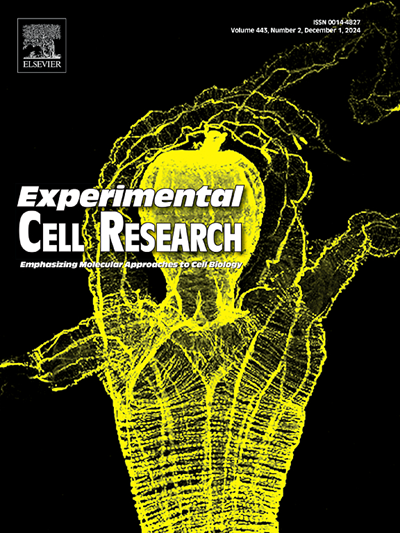CircBRWD1通过调节miR-513a-5p/TNPO1轴促进乙型肝炎病毒复制和肝细胞癌进展
IF 3.3
3区 生物学
Q3 CELL BIOLOGY
引用次数: 0
摘要
肝细胞癌(HCC),主要由慢性乙型肝炎病毒(HBV)感染引起,仍然是世界范围内肝癌的主要原因。尽管抗病毒治疗取得了进展,但由共价闭合环状DNA (cccDNA)介导的持续HBV复制导致HCC预后不良和频繁复发。本研究首次探讨环状RNA circBRWD1在HBV相关HCC中的作用,旨在阐明其在HBV复制和肝癌发生中的功能和调控机制。结果显示,与HBV阴性对照相比,circBRWD1在HBV阳性HCC组织和细胞系中显著过表达,并通过增加cccDNA积累促进HBV复制。沉默circBRWD1可显著降低HBV DNA、HBV表面抗原(HBsAg)、HBV e抗原(HBeAg)和HBV核心抗原(HBcAg)的水平,表明其在HBV复制中的关键作用。功能上,circBRWD1敲低导致HCC细胞增殖、集落形成和迁移减少,同时增加细胞凋亡。机制研究显示circBRWD1作为miR-513a-5p的海绵,从而上调TNPO1, TNPO1是促进HCC恶性肿瘤的关键角色。救援实验证实,TNPO1过表达逆转了circBRWD1缺失的作用,恢复了细胞增殖、迁移和HBV复制。此外,在小鼠异种移植模型中,circBRWD1缺失显著降低肿瘤生长,TNPO1表达降低,miR-513a-5p水平升高。总的来说,本研究确定circBRWD1是一个关键的致癌circRNA,通过miR-513a-5p/TNPO1轴促进HBV复制和HCC进展。靶向circBRWD1可能为HBV相关的HCC提供一种新的治疗策略,潜在地解决HBV持久性的挑战并改善患者的预后。本文章由计算机程序翻译,如有差异,请以英文原文为准。
CircBRWD1 promotes hepatitis B virus replication and hepatocellular carcinoma progression by regulating the miR-513a-5p/TNPO1 axis
Hepatocellular carcinoma (HCC), primarily caused by chronic hepatitis B virus (HBV) infection, remains a leading cause of liver cancer worldwide. Despite advances in antiviral therapies, persistent HBV replication, mediated by covalently closed circular DNA (cccDNA), contributes to poor prognoses and frequent recurrence of HCC. This study investigates for the first time the role of circular RNA circBRWD1 in HBV-related HCC, aiming to elucidate its function and regulatory mechanism in HBV replication and hepatocarcinogenesis. Results showed that circBRWD1 was significantly overexpressed in HBV-positive HCC tissues and cell lines compared to HBV-negative controls and promoted HBV replication by increasing cccDNA accumulation. Silencing circBRWD1 markedly reduced the levels of HBV DNA, HBV surface antigen (HBsAg), HBV e antigen (HBeAg), and HBV core antigen (HBcAg), indicating its critical role in HBV replication. Functionally, circBRWD1 knockdown led to reduced cell proliferation, colony formation, and migration while increasing apoptosis in HCC cells. Mechanistic studies revealed that circBRWD1 acts as a sponge for miR-513a-5p, thereby upregulating TNPO1, a key player in promoting HCC malignancy. Rescue experiments confirmed that TNPO1 overexpression reversed the effects of circBRWD1 depletion, restoring cell proliferation, migration, and HBV replication. Additionally, circBRWD1 depletion significantly reduced tumor growth with reduced expression of TNPO1 and increased miR-513a-5p levels in a mouse xenograft model. Collectively, this study identifies circBRWD1 as a key oncogenic circRNA that facilitates HBV replication and HCC progression via the miR-513a-5p/TNPO1 axis. Targeting circBRWD1 may offer a novel therapeutic strategy for HBV-related HCC, potentially addressing the challenge of HBV persistence and improving patient outcomes.
求助全文
通过发布文献求助,成功后即可免费获取论文全文。
去求助
来源期刊

Experimental cell research
医学-细胞生物学
CiteScore
7.20
自引率
0.00%
发文量
295
审稿时长
30 days
期刊介绍:
Our scope includes but is not limited to areas such as: Chromosome biology; Chromatin and epigenetics; DNA repair; Gene regulation; Nuclear import-export; RNA processing; Non-coding RNAs; Organelle biology; The cytoskeleton; Intracellular trafficking; Cell-cell and cell-matrix interactions; Cell motility and migration; Cell proliferation; Cellular differentiation; Signal transduction; Programmed cell death.
 求助内容:
求助内容: 应助结果提醒方式:
应助结果提醒方式:


